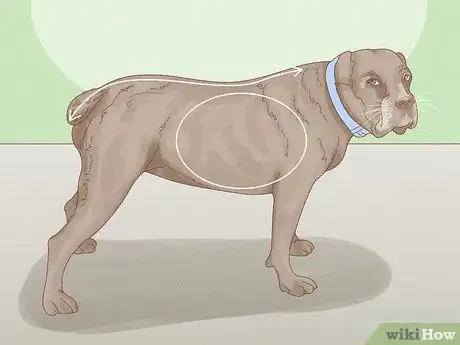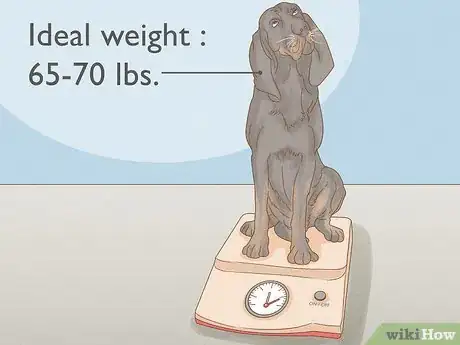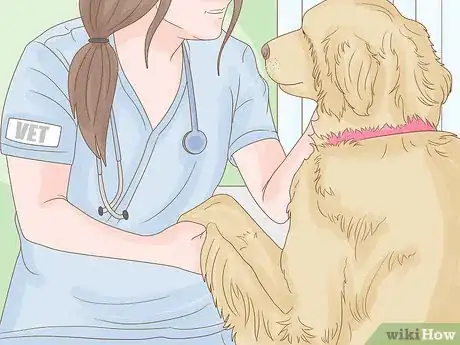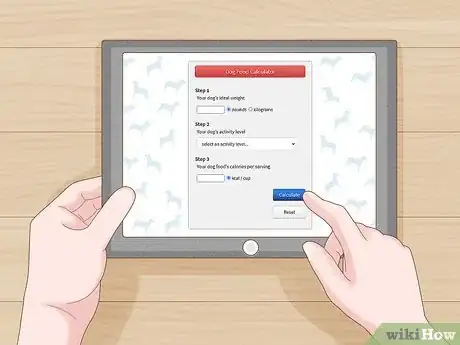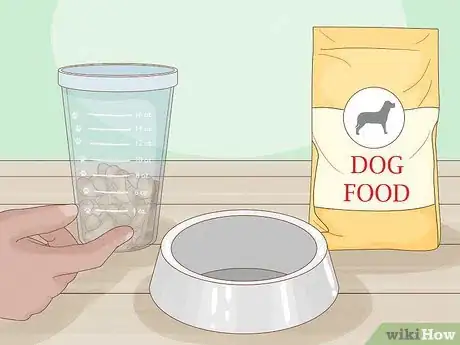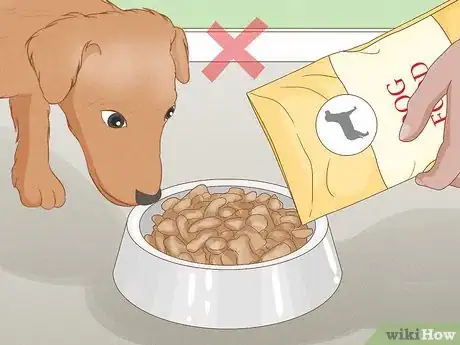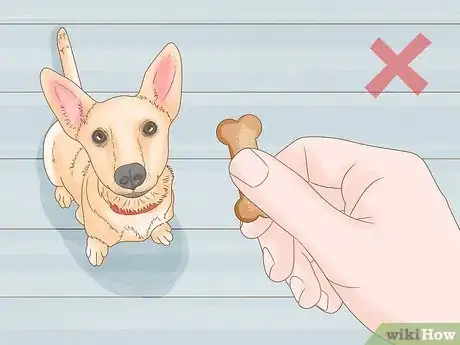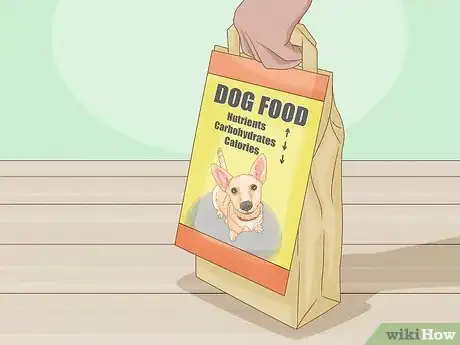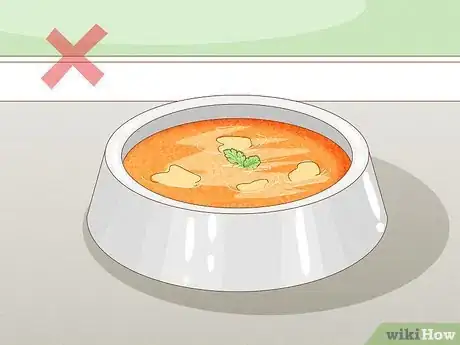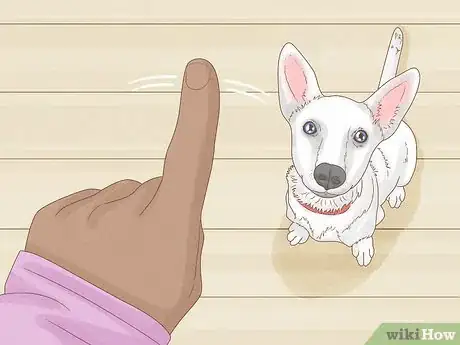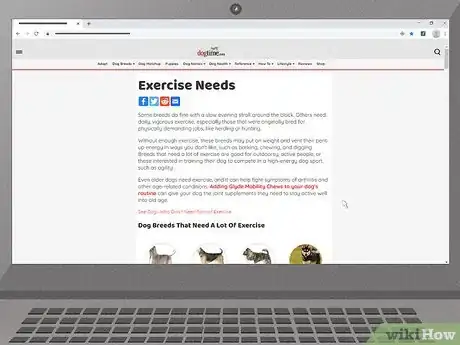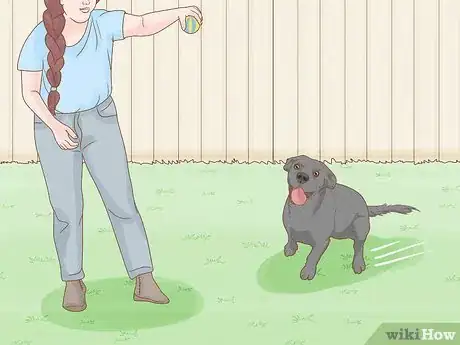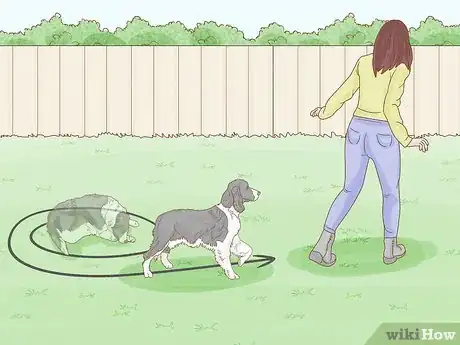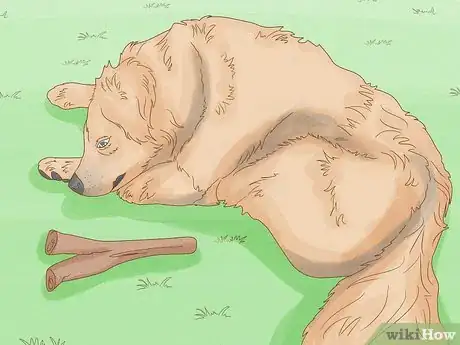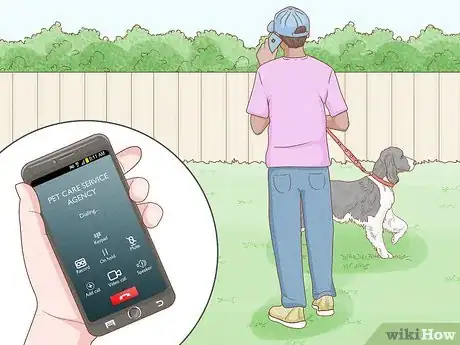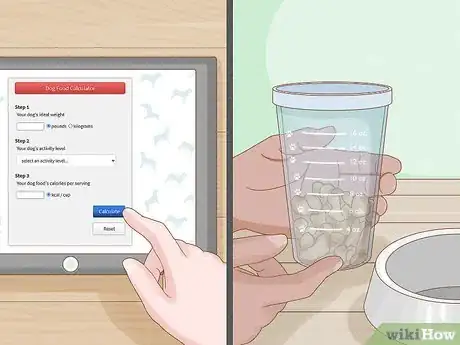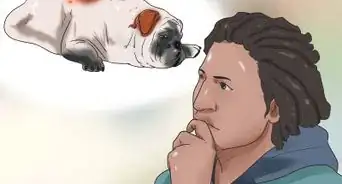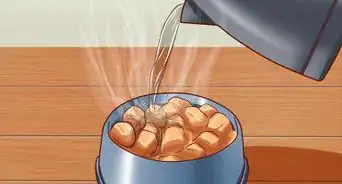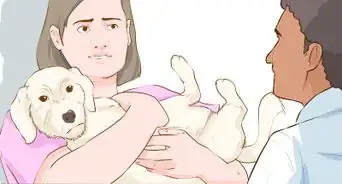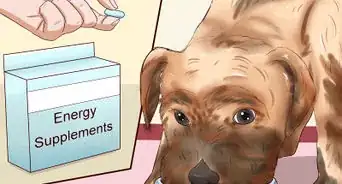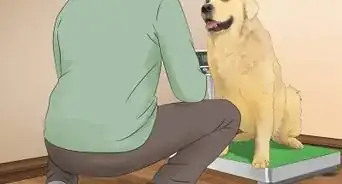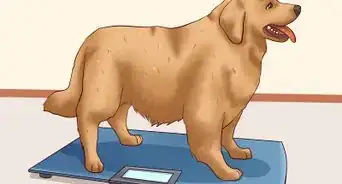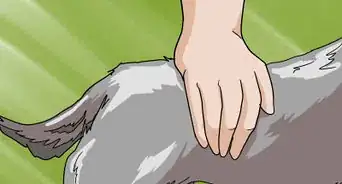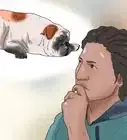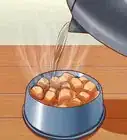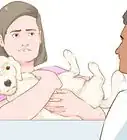This article was co-authored by Beatrice Tavakoli. Beatrice Tavakoli is a Professional Dog Trainer and the Founder/Owner of TAKA Dog Walk in New Jersey. A lifetime dog lover and enthusiast, Beatrice is committed to providing animals with hands-on service dedicated to daily love, adventure, and socialization. As insured and bonded dog walkers, Beatrice, and her staff provide a multitude of services including doggie social hour, day hikes, training, puppy care, canine special events, in-home pet care, boarding, cat care, and customized dog walks.
There are 14 references cited in this article, which can be found at the bottom of the page.
This article has been viewed 20,841 times.
Could your dog "stand to lose a few?" You're not alone — pet authorities now estimate that 45% of dogs in the U.S. qualify as either overweight or obese.[1] Unfortunately, these health problems can lead to shorter lifespans and greater likelihood of disease.[2] However, there's plenty of hope. With a healthy regimen of diet and exercise, nearly all dogs can lose weight for a happier, healthier life.
Steps
Identifying Obesity in Your Dog
Already know for certain that your dog is overweight or obese? Click here to go straight to the fitness tips.
-
1Check for external signs. Start by taking a close look at the dog's ribs and its vertebrae (the bones running down its back). Then, gently feel these bones. Look at the shape of the dog's body from above and from the side. Compare your findings to the information below:[3]
- Dogs with a healthy weight have ribs that you can see and feel easily, but that don't seem to "jut out" sharply (this is a sign of being underweight). The vertebrae should be a series of gentle bumps. Viewed from above, the dog should have a slight "hourglass" shape (its waist should be thinner than its hips and shoulders). Viewed from the side, the dog should have an "abdominal tuck" (its chest should be closer to the floor than its stomach).
- Overweight dogs have ribs that aren't easy to see or feel underneath a layer of fat. Fat deposits around the base of the tail and waist may also make it hard to see or feel some of the vertebrae. The dog will lack a noticeable "waist" when viewed from above and its stomach may hang as low (or lower) than its chest.
-
2Compare your dog's weight to the "ideal" weight for your breed. Just like humans have different body types, some dogs within the same breed will be naturally larger or smaller than others. However, there are certain "general rules" for the weights of different dog breeds that can help you judge whether or not your dog is obese. An excellent table of average dog weights by breed is available here.[4]
- Note: This chart won't work perfectly for mixed-breed dogs or mutts. You may want to try comparing your dog's weight to that of a similar breed or use the physical test above.
Advertisement -
3Take your dog to a vet to rule out medical causes for obesity. Just like humans, there are a few legitimate medical issues that can make a dog obese even if it lives a healthy lifestyle. Though these are more rare than "normal" obesity, they're worth considering. A veterinarian will be able to tell you whether your dog has one of these problems.
- Obesity-causing problems can include thyroid disorders, Cushing's disease, and diabetes.[5]
- Even if your dog doesn't have one of these problems, it's a good idea to take it to the vet if it's overweight anyway. Your vet will be able to offer expert advice to get your dog back in shape.
Improving Feeding Habits
-
1Use a calorie calculator to find your dog's ideal intake. Losing weight may not be easy, but it is easy to understand: your dog just needs to burn more calories every day than it eats and it will lose weight over time. The bigger this calorie gap, the faster it will lose weight. To figure out how much your dog should be eating, use a calorie calculator, like this one.[6] See below for instructions:
- You have two options for your dog's ideal weight — you can either enter the result from the chart linked to in the section above, or, if you want it to lose exactly 10 pounds, just enter 10 pounds less than its current weight.
- Next, enter its activity level from the list of options.
- Finally, enter the calories per serving of the dog food you're using. You can find this on its Nutrition Facts label.
- The answer you get will be how much you should feed your dog per day, not per meal. Divide this number by two if you feed your dog twice daily to find how much to feed it per meal. Divide by three if you feed it three times daily, and so on.
-
2Track your dog's calorie intake carefully. Making your dog lose weight is all about controlling the food it eats. Once you use the calculator above to determine how much it should be eating each day, stick to this nutritional plan. Use a measuring cup every time you feed your dog to make sure you give exactly the right amount of food.
-
3Avoid "free feeding." Some owners have a "free feeding" policy for their dog — in other words, the dog is given access to food whenever it wants it. Unfortunately, this will make weight loss almost impossible. A dog with unlimited access to food will be able to eat as soon as it feels the first twinges of hunger from its new diet, so it won't ever accumulate a calorie deficit and start losing weight.[7]
- In addition, free-fed dogs can get in the habit of eating out of boredom, even when they're not hungry (just like humans).[8]
- Switching from free feeding to better feeding practices is easy. One vet source recommends determining how much food the dog needs in each meal (see above), then putting out exactly this amount at each mealtime. If the dog doesn't finish it within 15 minutes, take it away and don't offer any more food until the next meal.[9] It will quickly learn to eat the meals it is given.
-
4Avoid using snacks and treats as rewards. If you're used to giving your dogs treats throughout the day, it can seem cruel to stop. It may feel like you're depriving your dog of a source of happiness. However, you're actually doing the opposite — by helping your dog lose weight, you're giving it a happier, healthier life in the long run. Here are just a few things you can use as rewards for good behavior instead of food:
- Playtime
- Exercise
- Petting
- Cuddling
- If you do need to use treats, use very small portions. Most dogs are simply attracted to the tantalizing smell of the treat — they don't need to use them as a major source of calories.[10]
-
5Consider switching to a high-quality dog food. It's not all about how much your dog eats — it's also about what it's eating. The best dog foods provide plenty of protein, while offering lower-than-average carbohydrates and calories.[11] These dog foods help a dog stay full for longer, making it easier for it to adjust to its diet. They also more closely mirror the dog's natural diet.
- A good selection of well-reviewed dog foods are available here.[12]
- If your new dog food has a different calorie content than your old food, don't forget to use the calorie calculator again to determine your dog's new portion sizes.
- Dogs can have digestive distress if their entire diet is suddenly changed. To avoid this, try introducing the new food gradually. You can try offering frequent small meals or mixing it with the dog's old food at first, then transition to two or three meals per day of the new food.[13]
-
6Avoid human food. With a few exceptions, food that's meant for people to eat isn't usually good for your dog. These foods (particularly human snack foods) can be calorie-dense and lack the nutrients that dogs need to stay healthy.
- In addition, because these foods weren't part of dogs' natural diets, they can produce unexpected digestive effects. In particular, chocolate, caffeine, alcohol, avocado, some nuts, grapes and raisins, raw meat and eggs, dairy, onions, garlic, and chives can produce side effects that range from mild to severe.[14]
-
7Resist the urge to give in to "puppy eyes." Though they are cute, loyal companions, dogs are also selfish. They won't feel an ounce of shame begging or harassing you for the "bad" foods they've become accustomed to.[15] Ignore your dog's pleading and offer it only proper, nutritious dog food at approved meal times. If it doesn't eat this food, don't give it anything else. No healthy dog will starve itself — it will soon be eating the food you give it.
- Consistency is important here. Be sure to educate the people you live with not to feed the dog improper foods. If they do, the dog will quickly learn who's "soft" and won't lose its bad habits. You'll also want to avoid leaving food in places where your dog can get it while it's adjusting to its new diet.
Improving Exercise Habits
-
1Research your breed's exercise needs. Some dog breeds are happiest with an occasional short walk, while others need strenuous exercise daily. If you're not sure how much exercise your dog needs, try looking online, where this information is freely available. Here is a good site that offers exercise specifics on many breeds.
- Keeping a dog from meeting its natural exercise needs isn't just unhealthy — it's unfair to the dog. A lack of exercise can leave the dog unhappy and hyperactive, leading to numerous behavior disorders. These include excessive barking, destructive chewing, abnormal sleep schedules, rough play, and more.[16]
-
2Find exercise opportunities that work for you. If your dog isn't getting enough exercise, don't worry — there are many ways to get it the exercise it needs. Best of all, many of these can give you a workout as well. Good ideas for exercise include:
- Good for nearly all breeds: Fetch, neighborhood walks, chase, tug-of-war, play-wrestling, laser pointer play, playtime with other dogs.
- Good for breeds with high exercise needs: Running or jogging, hikes, prolonged soccer-style games, swimming (best for natural water dogs — do not allow dogs to swim unattended).
-
3Know how to motivate a lazy dog. Not all dogs will "jump" at the opportunity to start exercising. This may be especially true if your dog is already obese. If you find it tough to get your dog to start exercising (or to get it to keep exercising once it's out of the house), try these tricks:
- Circle around your dog a few times, talking in an encouraging voice, and then start moving in the direction you want it to go. This will often make dogs want to follow you.
- Teach your dog the "Let's go" command. See here for more information.[17]
- Give the dog a chance to rest, then, when it gets up on its own, offer it a small treat (or some affection if it's on a strict diet). Don't use the treat to make it get up in the first place — this will just reward its laziness.
- If nothing you do seems to make your dog want to exercise, bring it to a vet to rule out health problems.
-
4Watch for signs of exhaustion. Just like people, dogs can't exercise forever without a break. If your dog is overweight or obese, it may be able to only exercise a little bit before it gets tired. Don't exercise your dog past the point of exhaustion — this is unsafe. Give your dog ample opportunities to rest in the shade (especially if it's hot out) and give your dog plenty of water to avoid dehydration.
- If your dog has any health conditions you are aware of, talk to a vet before starting its exercise program. Some issues, like many heart conditions, can get worse with exercise.
-
5If necessary, make arrangements with outside help. If your schedule doesn't allow for your dog to get as much exercise as it needs, consider hiring a pet care service to fill in the gaps for you. Many areas have local agencies that, for a reasonable fee, can walk your dog, play with it, and more — perfect for someone with a demanding job.
- One pet care agency with a wide reach is Fetch! Pet Care, which has services in most (but not all) U.S. states. You can try to find a location near you with the service locator available here.[18] Not that Fetch! is a franchise business, so quality can vary from location to location.
- You may also be able to find local small businesses willing to provide similar services. Be sure to look for reviews or testimonials on sites like Yelp! to ensure the business you've chosen is a reputable one.
-
6Don't forget to adjust its food intake accordingly. When a dog exercises, its body burns more energy in the form of calories than normal. This will help it lose weight but burning too many calories without replacing them can be unhealthy. For this reason, if your dog suddenly starts a new, more intense exercise routine, use the calorie calculator in the section above to re-calculate its ideal food intake. There's a good chance you'll need to feed it slightly more than if it were dieting without the exercise.
Expert Q&A
-
QuestionWill treats make my dog fat?
 Beatrice TavakoliBeatrice Tavakoli is a Professional Dog Trainer and the Founder/Owner of TAKA Dog Walk in New Jersey. A lifetime dog lover and enthusiast, Beatrice is committed to providing animals with hands-on service dedicated to daily love, adventure, and socialization. As insured and bonded dog walkers, Beatrice, and her staff provide a multitude of services including doggie social hour, day hikes, training, puppy care, canine special events, in-home pet care, boarding, cat care, and customized dog walks.
Beatrice TavakoliBeatrice Tavakoli is a Professional Dog Trainer and the Founder/Owner of TAKA Dog Walk in New Jersey. A lifetime dog lover and enthusiast, Beatrice is committed to providing animals with hands-on service dedicated to daily love, adventure, and socialization. As insured and bonded dog walkers, Beatrice, and her staff provide a multitude of services including doggie social hour, day hikes, training, puppy care, canine special events, in-home pet care, boarding, cat care, and customized dog walks.
Professional Dog Trainer If your dog needs to lose weight and you still want to give them treats, break the treat into tiny pieces. The dog is going to be happy because they're getting treated―they don't really care about the size.
If your dog needs to lose weight and you still want to give them treats, break the treat into tiny pieces. The dog is going to be happy because they're getting treated―they don't really care about the size. -
QuestionIs it okay to leave food out for my dog?
 Beatrice TavakoliBeatrice Tavakoli is a Professional Dog Trainer and the Founder/Owner of TAKA Dog Walk in New Jersey. A lifetime dog lover and enthusiast, Beatrice is committed to providing animals with hands-on service dedicated to daily love, adventure, and socialization. As insured and bonded dog walkers, Beatrice, and her staff provide a multitude of services including doggie social hour, day hikes, training, puppy care, canine special events, in-home pet care, boarding, cat care, and customized dog walks.
Beatrice TavakoliBeatrice Tavakoli is a Professional Dog Trainer and the Founder/Owner of TAKA Dog Walk in New Jersey. A lifetime dog lover and enthusiast, Beatrice is committed to providing animals with hands-on service dedicated to daily love, adventure, and socialization. As insured and bonded dog walkers, Beatrice, and her staff provide a multitude of services including doggie social hour, day hikes, training, puppy care, canine special events, in-home pet care, boarding, cat care, and customized dog walks.
Professional Dog Trainer It's not a good idea to let dogs graze all day—it's not how their stomachs are meant to work. Instead, feed your dog as designated times during the day. It will keep your dog healthier, and your dog will be more likely to eat all of their food when that meal time comes.
It's not a good idea to let dogs graze all day—it's not how their stomachs are meant to work. Instead, feed your dog as designated times during the day. It will keep your dog healthier, and your dog will be more likely to eat all of their food when that meal time comes.
References
- ↑ http://www.dogfoodadvisor.com/dog-feeding-tips/dog-lose-weight/#fn-2975-1
- ↑ http://www.dogfoodadvisor.com/dog-feeding-tips/dog-ideal-weight/
- ↑ http://www.dogfoodadvisor.com/dog-feeding-tips/dog-ideal-weight/
- ↑ https://www.petcarerx.com/article/dog-breed-weight-chart/267
- ↑ http://www.dogfoodadvisor.com/dog-feeding-tips/dog-lose-weight/#fn-2975-1
- ↑ http://www.dogfoodadvisor.com/dog-feeding-tips/dog-food-calculator/
- ↑ Beatrice Tavakoli. Professional Dog Trainer. Expert Interview. 26 February 2021.
- ↑ http://www.dogfoodadvisor.com/dog-feeding-tips/dog-lose-weight/#fn-2975-1
- ↑ http://www.petmd.com/blogs/nutritionnuggets/2012/feb/jcoates/free_feeding_is_wrong_choice_for_most_dogs-12694
- ↑ Beatrice Tavakoli. Professional Dog Trainer. Expert Interview. 26 February 2021.
- ↑ http://www.dogfoodadvisor.com/dog-feeding-tips/dog-lose-weight/#fn-2975-1
- ↑ http://www.dogfoodadvisor.com/dog-food-reviews/dry/5-star/
- ↑ http://www.petmd.com/dog/nutrition/evr_dg_changing_dog_food_brands_quickly
- ↑ https://www.aspca.org/pet-care/animal-poison-control/people-foods-avoid-feeding-your-pets
- ↑ http://www.montrealdogblog.com/9366/trainer-dog-eats-people-food/
- ↑ https://www.aspca.org/pet-care/virtual-pet-behaviorist/dog-behavior/exercise-dogs
- ↑ http://dogscience.org/workshop/letsgo.shtml
- ↑ https://www.fetchpetcare.com/locations/
- ↑ http://www.petmd.com/dog/conditions/respiratory/c_multi_brachycephalic_airway_syndrome
About This Article
To get your dog to lose 10 pounds, start by finding an online calorie calculator to work out how much your dog needs to eat in order to lose weight. Then, use a measuring cup every time you feed your dog to ensure you’re not giving it too much. Additionally, avoid giving your dog human food, which has more calories and lacks nutrients. You should also exercise your dog by taking it for walks or playing games, like fetch. However, give your dog a break whenever you notice signs of exhaustion, and provide plenty of water to prevent dehydration. For tips on how to reward your dog without giving it treats, read on!
